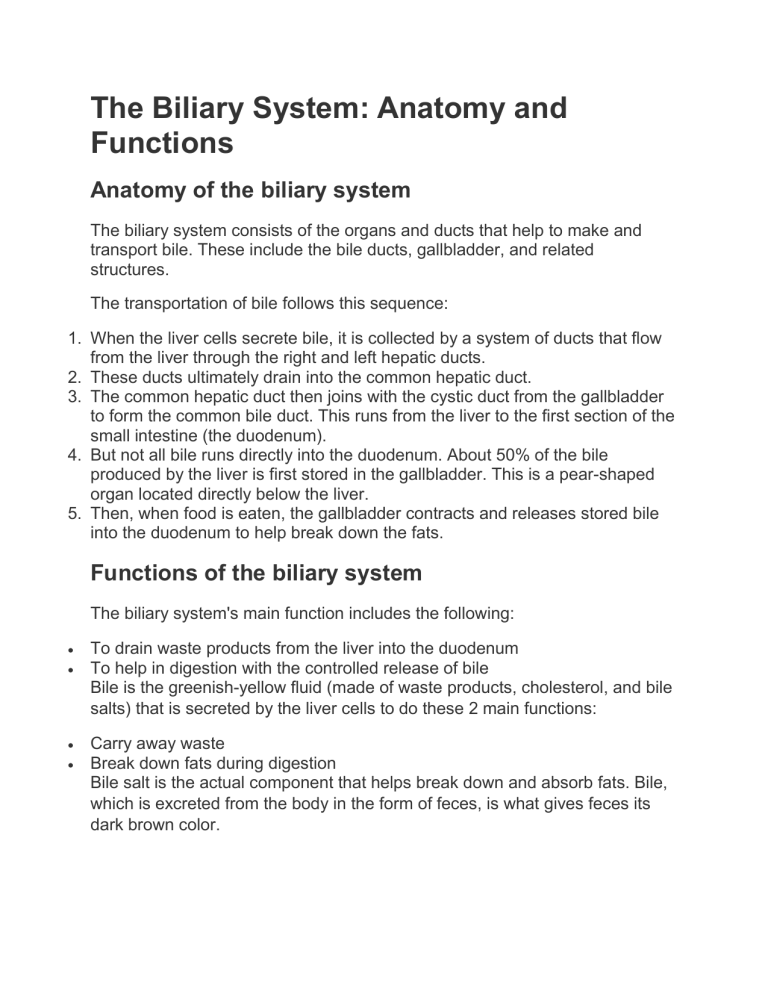
The Biliary System: Anatomy and Functions Anatomy of the biliary system The biliary system consists of the organs and ducts that help to make and transport bile. These include the bile ducts, gallbladder, and related structures. The transportation of bile follows this sequence: 1. When the liver cells secrete bile, it is collected by a system of ducts that flow from the liver through the right and left hepatic ducts. 2. These ducts ultimately drain into the common hepatic duct. 3. The common hepatic duct then joins with the cystic duct from the gallbladder to form the common bile duct. This runs from the liver to the first section of the small intestine (the duodenum). 4. But not all bile runs directly into the duodenum. About 50% of the bile produced by the liver is first stored in the gallbladder. This is a pear-shaped organ located directly below the liver. 5. Then, when food is eaten, the gallbladder contracts and releases stored bile into the duodenum to help break down the fats. Functions of the biliary system The biliary system's main function includes the following: To drain waste products from the liver into the duodenum To help in digestion with the controlled release of bile Bile is the greenish-yellow fluid (made of waste products, cholesterol, and bile salts) that is secreted by the liver cells to do these 2 main functions: Carry away waste Break down fats during digestion Bile salt is the actual component that helps break down and absorb fats. Bile, which is excreted from the body in the form of feces, is what gives feces its dark brown color. Liver, pancreas, gallbladder, and biliary system The liver is the major solid organ in the RUQ, with the gallbladder tucked inferiorly. The liver is supplied by both the hepatic arterial system (arising from the abdominal aorta, usually the celiac artery) and the portal venous system (which drains blood from the bowel and spleen). The latter provides the majority of hepatic blood supply. The hepatic venous system (consisting of the right, middle, and left hepatic veins) drains blood from the liver to the IVC. In terms of segmentation, functional anatomy is more relevant in imaging than traditional gross anatomy. Functionally speaking, the liver is divided into the right and left lobes via Cantlie’s line inferiorly (drawn from the gallbladder fossa to the IVC) and the middle hepatic vein superiorly. The fossa for ligamentum teres divides the functional left hepatic lobes into medial and lateral segments. The bile produced by the liver is taken downstream via the right and left hepatic bile ducts, which combine to form the common hepatic duct. This bile is then either stored in the gallbladder (which connects to the common hepatic duct via the cystic duct) or supplied to the duodenum (via the CBD; Figure 5.8). The pancreas is a primarily retroperitoneal organ, which has a close relationship with the duodenum. The exocrine pancreas generates digestive enzymes, which are supplied to the duodenum via the pancreatic duct. As discussed previously, the CBD and pancreatic duct deposit their respective contents into the duodenum via the ampulla of Vater.






